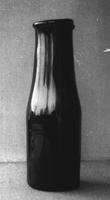








Canning is a method of preserving food in which the food contents are processed and sealed in an airtight container. Canning provides a shelf life typically ranging from one to five years, although under specific circumstances it can be much longer. A freeze-dried canned product, such as canned dried lentils, could last as long as 30 years in an edible state. In 1974, samples of canned food from the wreck of the Bertrand, a steamboat that sank in the Missouri River in 1865, were tested by the National Food Processors Association. Although appearance, smell and vitamin content had deteriorated, there was no trace of microbial growth and the 109 year-old food was determined to be still safe to eat.
In 1809, Nicolas Appert, a French confectioner and brewer, observed that food cooked inside a jar did not spoil unless the seals leaked, and developed a method of sealing food in glass jars.The reason for lack of spoilage was unknown at the time, since it would be another 50 years before Louis Pasteur demonstrated the role of microbes in food spoilage. However, glass containers presented challenges for transportation.
Originally, cans consisted of a sheet of tin-plated iron that was rolled into a cylinder (known as the body), onto which the top and bottom were manually soldered. This form was replaced in the early 20th century by the modern sanitary, or open-top, can, whose constituent parts are joined by interlocking folds that are crimped, or pressed together. Polymer sealing compounds are applied to the end, or lid, seams, and the body seams can be sealed on the outside by soldering. The modern tin can is made of 98.5 percent sheet steel with a thin coating of tin (i.e., tinplate). It is manufactured on wholly automatic lines of machinery at rates of hundreds of cans per minute.
Most vegetables, fruits, meat and dairy products, and processed foods are stored in tin cans, but soft drinks and many other beverages are now commonly stored in aluminum cans, which are lighter and do not rust. Aluminum cans are made by impact extrusion; the body of the can is punched out in one piece from a single aluminum sheet by a stamping die. This seamless piece, which has a rounded bottom, is then capped with a second piece as its lid. The tabs used in pop-top cans are also made of aluminum. Bimetal cans are made of aluminum bodies and steel lids.
Canneries are usually located close to the growing areas of the product to be packed, since it is desirable to can foods as quickly as possible after harvesting. The canning process itself consists of several stages: cleaning and further preparing the raw food material; blanching it; filling the containers, usually under a vacuum; closing and sealing the containers; sterilizing the canned products; and labeling and warehousing the finished goods. Cleaning usually involves passing the raw food through tanks of water or under high-pressure water sprays, after which vegetable or other products are cut, peeled, cored, sliced, graded, soaked, pureed, and so on. Almost all vegetables and some fruits require blanching by immersion in hot water or steam; this process softens the vegetable tissues and makes them pliable enough to be packed tightly, while also serving to inactivate enzymes that can cause undesirable changes in the food before canning. Blanching also serves as an additional or final cleansing operation.
The filling of cans is done automatically by machines; cans are filled with solid contents and, in many cases, with an accompanying liquid (often brine or syrup) in order to replace as much of the air in the can as possible. The filled cans are then passed through a hot-water or steam bath in an exhaust box; this heating expands the food and drives out the remaining air; thus, after sealing, heat sterilizing, and cooling the can, the contraction of the contents produces a partial vacuum within the container. Certain products are vacuum-packed, whereby the cans are mechanically exhausted by specially designed vacuum-can sealing machines.
Immediately after the cans are exhausted, they are closed and sealed; a machine places the cover on the can, and the curl on the can cover and the flange on the can body are rolled into position and then flattened together. The thin layer of sealing compound originally present in the rim of the cover is dispersed between the layers of metal to ensure a hermetic seal. The sealed cans are then sterilized; i.e., they are heated at temperatures high enough and for a long enough time to destroy all microorganisms (bacteria, molds, yeasts) that might still be present in the food contents. The heating is done in high-pressure steam kettles, or cookers, usually using temperatures around 240° F (116° C). The cans are then cooled in cold water or air, after which they are labeled.
Canning preserves most of the nutrients in foods. Proteins, carbohydrates, and fats are unaffected, as are vitamins A, C, D, and B2. The retention of vitamin B1 depends on the amount of heat used during canning. Some vitamins and minerals may dissolve into the brine or syrup in a can during processing, but they retain their nutritive value if those liquids are consumed.